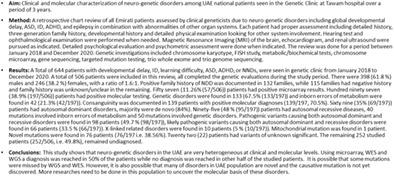当前位置:
X-MOL 学术
›
Clin. Genet.
›
论文详情
Our official English website, www.x-mol.net, welcomes your feedback! (Note: you will need to create a separate account there.)
Spectrum of neuro-genetic disorders in the United Arab Emirates national population
Clinical Genetics ( IF 3.5 ) Pub Date : 2021-08-10 , DOI: 10.1111/cge.14044 Sirine Saleh 1 , Ela Beyyumi 1 , Aysha Al Kaabi 1 , Jozef Hertecant 2 , Doaa Barakat 3 , Noura S Al Dhaheri 4 , Lihadh Al-Gazali 5 , Aisha Al Shamsi 2
Clinical Genetics ( IF 3.5 ) Pub Date : 2021-08-10 , DOI: 10.1111/cge.14044 Sirine Saleh 1 , Ela Beyyumi 1 , Aysha Al Kaabi 1 , Jozef Hertecant 2 , Doaa Barakat 3 , Noura S Al Dhaheri 4 , Lihadh Al-Gazali 5 , Aisha Al Shamsi 2
Affiliation

|
Clinical and molecular characterization of neuro-genetic disorders among UAE national patients seen in the Genetic Clinic at Tawam hospital over a period of 3 years. A retrospective chart review of all Emirati patients assessed by clinical geneticists due to neuro-genetic disorders including global developmental delay, ASD, ID, ADHD, and epilepsy in combination with abnormalities of other organ systems. Each patient had proper assessment including detailed history, three-generation family history, developmental history and detailed physical examination looking for other system involvement. Hearing test and ophthalmological examination were performed when needed. Magnetic resonance imaging (MRI) of the brain, echocardiogram, and renal ultrasound were pursued as indicated. Detailed psychological evaluation and psychometric assessment were done when indicated. The review was done for a period between January 2018 and December 2020. Genetic investigations included chromosome karyotype, FISH study, metabolic/biochemical tests, chromosome microarray, gene sequencing, targeted mutation testing, trio whole exome and trio genome sequencing. A total of 644 patients with developmental delay, ID, learning difficulty, ASD, ADHD, or NNDs, were seen in genetic clinic from January 2018 to December 2020. A total of 506 patients were included in this review, all completed the genetic evaluations during the study period. There were 398 (61.8%) males and 246 (38.2%) females, with a ratio of 1.6:1. Positive family history of NDD was documented in 132 families, while 115 families had negative history and family history was unknown/unclear in the remaining. Fifty seven (11.26% [57/506]) patients had positive microarray results. Hundred ninety seven (38.9% [197/506]) patients had positive molecular testing. Genetic disorders were found in 133 (67.5% [133/197]) and inborn errors of metabolism were found in 42 (21.3% [42/197]). Consanguinity was documented in 139 patients with positive molecular diagnoses (139/197, 70.5%). Sixty nine (35% [69/197]) patients had autosomal dominant disorders, majority were De Novo (84%). Ninety-five (48% [95/197]) patients had autosomal recessive diseases, 40 mutations involved inborn errors of metabolism and 50 mutations involved genetic disorders. Pathogenic variants causing both autosomal dominant and recessive disorders were found in 98 patients (49.7% [98/197]), likely pathogenic variants causing both autosomal dominant and recessive disorders were found in 66 patients (33.5% [66/197]). X-linked related disorders were found in 10 patients (5% [10/197]). Mitochondrial mutation was found in one patient. Novel mutations were found in 76 patients (76/197 i.e., 38.56%). Twenty two patients had variants of unknown significant. The remaining 252 studied patients (252/506 i.e., 49.8%), remained undiagnosed. This study shows that neuro-genetic disorders in the UAE are very heterogeneous at clinical and molecular levels. Using microarray, WES and WGS a diagnosis was reached in 50% of the patients while no diagnosis was reached in other half of the studied patients. It is possible that some mutations were missed by WGS and WES. However, it is also possible that many of disorders in UAE population are novel and the causative mutation is not yet discovered. More researches need to be done in this population to uncover the molecular basis of these disorders.
中文翻译:

阿拉伯联合酋长国国家人口的神经遗传疾病谱
在 3 年内在 Tawam 医院的遗传诊所看到的阿联酋国家患者的神经遗传疾病的临床和分子特征。由临床遗传学家评估的所有阿联酋患者的回顾性图表回顾,这些患者因神经遗传疾病(包括全球发育迟缓、ASD、ID、ADHD 和癫痫以及其他器官系统异常)而进行评估。每位患者都有适当的评估,包括详细的病史、三代家族史、发育史和详细的体格检查,以寻找其他系统参与。必要时进行听力测试和眼科检查。按照指示进行脑磁共振成像 (MRI)、超声心动图和肾脏超声检查。在需要时进行详细的心理评估和心理测量评估。审查时间为 2018 年 1 月至 2020 年 12 月。遗传调查包括染色体核型、FISH 研究、代谢/生化测试、染色体微阵列、基因测序、靶向突变测试、三重全外显子组和三重基因组测序。2018 年 1 月至 2020 年 12 月在遗传诊所就诊的发育迟缓、ID、学习困难、ASD、ADHD 或 NND 患者共 644 例。本次综述共纳入 506 例患者,均完成了遗传评估。学习期间。男性398人(61.8%),女性246人(38.2%),比例为1.6:1。NDD阳性家族史记录在132个家庭中,而115个家庭有阴性病史,其余的家庭病史未知/不清楚。57 名 (11.26% [57/506]) 患者的微阵列结果呈阳性。一百九十七名(38.9% [197/506])患者的分子检测呈阳性。133 人 (67.5% [133/197]) 发现遗传疾病,42 人 (21.3% [42/197]) 发现先天性代谢错误。139 名分子诊断为阳性的患者(139/197,70.5%)记录了血缘关系。69 名 (35% [69/197]) 患者患有常染色体显性遗传疾病,大多数是新发疾病 (84%)。95 名 (48% [95/197]) 患者患有常染色体隐性遗传病,40 种突变涉及先天性代谢错误,50 种突变涉及遗传疾病。在 98 名患者 (49.7% [98/197]) 中发现了导致常染色体显性和隐性遗传疾病的致病变异,在 66 名患者 (33.5% [66/197]) 中发现了可能导致常染色体显性和隐性遗传疾病的致病变异。在 10 名患者 (5% [10/197]) 中发现了 X 连锁相关疾病。一名患者发现线粒体突变。在 76 名患者(76/197 即 38.56%)中发现了新的突变。22 名患者有未知显着性变异。其余 252 名研究患者(252/506 即 49.8%)仍未确诊。这项研究表明,阿联酋的神经遗传疾病在临床和分子水平上存在很大差异。使用微阵列、WES 和 WGS,50% 的患者得到诊断,而另一半研究患者没有得到诊断。WGS 和 WES 可能遗漏了一些突变。然而,阿联酋人群中的许多疾病也可能是新的,尚未发现致病突变。需要在这一人群中进行更多的研究,以揭示这些疾病的分子基础。
更新日期:2021-10-07
中文翻译:

阿拉伯联合酋长国国家人口的神经遗传疾病谱
在 3 年内在 Tawam 医院的遗传诊所看到的阿联酋国家患者的神经遗传疾病的临床和分子特征。由临床遗传学家评估的所有阿联酋患者的回顾性图表回顾,这些患者因神经遗传疾病(包括全球发育迟缓、ASD、ID、ADHD 和癫痫以及其他器官系统异常)而进行评估。每位患者都有适当的评估,包括详细的病史、三代家族史、发育史和详细的体格检查,以寻找其他系统参与。必要时进行听力测试和眼科检查。按照指示进行脑磁共振成像 (MRI)、超声心动图和肾脏超声检查。在需要时进行详细的心理评估和心理测量评估。审查时间为 2018 年 1 月至 2020 年 12 月。遗传调查包括染色体核型、FISH 研究、代谢/生化测试、染色体微阵列、基因测序、靶向突变测试、三重全外显子组和三重基因组测序。2018 年 1 月至 2020 年 12 月在遗传诊所就诊的发育迟缓、ID、学习困难、ASD、ADHD 或 NND 患者共 644 例。本次综述共纳入 506 例患者,均完成了遗传评估。学习期间。男性398人(61.8%),女性246人(38.2%),比例为1.6:1。NDD阳性家族史记录在132个家庭中,而115个家庭有阴性病史,其余的家庭病史未知/不清楚。57 名 (11.26% [57/506]) 患者的微阵列结果呈阳性。一百九十七名(38.9% [197/506])患者的分子检测呈阳性。133 人 (67.5% [133/197]) 发现遗传疾病,42 人 (21.3% [42/197]) 发现先天性代谢错误。139 名分子诊断为阳性的患者(139/197,70.5%)记录了血缘关系。69 名 (35% [69/197]) 患者患有常染色体显性遗传疾病,大多数是新发疾病 (84%)。95 名 (48% [95/197]) 患者患有常染色体隐性遗传病,40 种突变涉及先天性代谢错误,50 种突变涉及遗传疾病。在 98 名患者 (49.7% [98/197]) 中发现了导致常染色体显性和隐性遗传疾病的致病变异,在 66 名患者 (33.5% [66/197]) 中发现了可能导致常染色体显性和隐性遗传疾病的致病变异。在 10 名患者 (5% [10/197]) 中发现了 X 连锁相关疾病。一名患者发现线粒体突变。在 76 名患者(76/197 即 38.56%)中发现了新的突变。22 名患者有未知显着性变异。其余 252 名研究患者(252/506 即 49.8%)仍未确诊。这项研究表明,阿联酋的神经遗传疾病在临床和分子水平上存在很大差异。使用微阵列、WES 和 WGS,50% 的患者得到诊断,而另一半研究患者没有得到诊断。WGS 和 WES 可能遗漏了一些突变。然而,阿联酋人群中的许多疾病也可能是新的,尚未发现致病突变。需要在这一人群中进行更多的研究,以揭示这些疾病的分子基础。



























 京公网安备 11010802027423号
京公网安备 11010802027423号